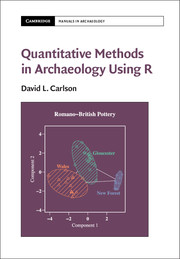Book contents
- Frontmatter
- Contents
- List of Figures
- List of Tables
- List of Boxes
- Acknowledgments
- 1 Introduction
- PART I R AND BASIC STATISTICS
- PART II MULTIVARIATE METHODS
- 10 Multiple Regression and Generalized Linear Models
- 11 MANOVA and Discriminant Analysis
- 12 Principal Components Analysis
- 13 Correspondence Analysis
- 14 Distances and Scaling
- 15 Cluster Analysis
- PART III ARCHAEOLOGICAL APPROACHES TO DATA
- References
- Index
14 - Distances and Scaling
from PART II - MULTIVARIATE METHODS
Published online by Cambridge University Press: 22 July 2017
- Frontmatter
- Contents
- List of Figures
- List of Tables
- List of Boxes
- Acknowledgments
- 1 Introduction
- PART I R AND BASIC STATISTICS
- PART II MULTIVARIATE METHODS
- 10 Multiple Regression and Generalized Linear Models
- 11 MANOVA and Discriminant Analysis
- 12 Principal Components Analysis
- 13 Correspondence Analysis
- 14 Distances and Scaling
- 15 Cluster Analysis
- PART III ARCHAEOLOGICAL APPROACHES TO DATA
- References
- Index
Summary
We have discussed the concepts of multivariate spaces and distances in earlier chapters. With discriminant analysis, we created a space that separated groups of observations. With principal components, we defined a multivariate space for the observations in fewer dimensions while losing the least amount of information. With correspondence analysis, we displayed observations and variables in terms of their Chi-square distances. This chapter is the first of two that focus on quantitative methods that start with a distance matrix and represent the distances between observations either in the form of a map (this chapter) or by grouping observations that are similar (Chapter 15). In both cases we generally start by computing a distance or similarity measure between pairs of observations.
The first part of the chapter describes different ways of defining distance and similarity. Different choices in the measurement of distance can have substantial influence on the results. The second part describes ways of analyzing distance matrices in order to represent them in the form of a map. If you have ever looked at a highway map, you may have noticed a triangular table of distances between major cities. What if you only had the table of distances? How would you go about reconstructing the map? Scaling methods were primarily developed in the field of psychology where data expressing perception or preferences are gathered directly in the form of a similarity matrix that reflects judgments regarding how similar pairs of stimuli are. In archaeology, the classic application is seriation, which attempts to represent variation in assemblages along a single dimension that may represent time (Chapter 17). The third part of the chapter illustrates how to compare two distance matrices. For example, if we have sites located in a region and collections of ceramics from those sites, how do we compare the geographic distances to ceramic assemblage distances?
DISTANCE, DISSIMILARITY, AND SIMILARITY
The term distance refers to a numeric score that indicates how close or far two observations are in terms of a set of variables. Larger distances mean the observations are less similar to one another. Dissimilarity measures are larger when two objects are more distant or different from one another. Similarity measures are larger when two objects are more like one another.
- Type
- Chapter
- Information
- Quantitative Methods in Archaeology Using R , pp. 296 - 317Publisher: Cambridge University PressPrint publication year: 2017



